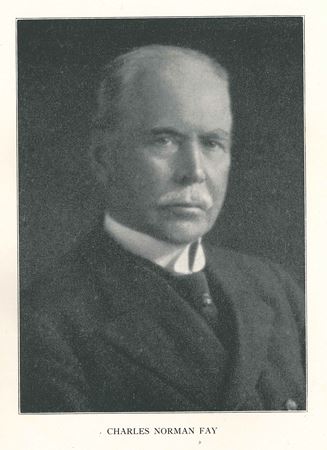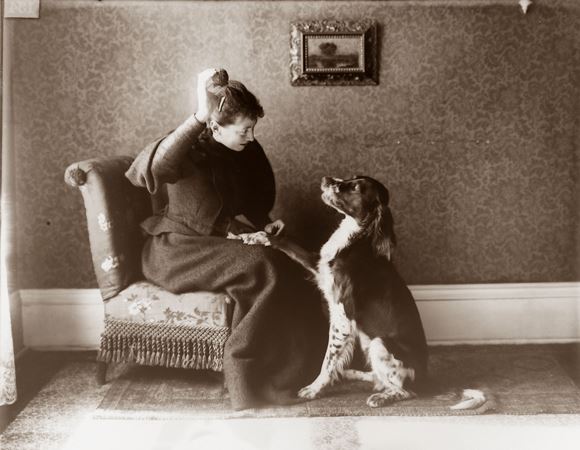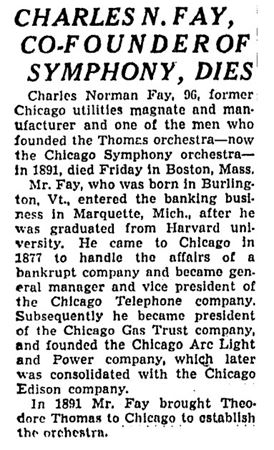Born August 13, 1848; Burlington, Vermont
Died April 7, 1944; Cambridge, Massachusetts
"To Theodore Thomas we must ascribe all honor as the founder of our Orchestra, but to Charles Norman Fay, a man endowed with a genius for organization and executive work, is due equal honor for the first thought of the Orchestra. . . . It was Mr. Fay who suggested to Mr. Thomas the formation of a permanent Orchestra in Chicago, and who provided the ways and means for his coming as its Conductor." — Philo Adams Otis, The Chicago Symphony Orchestra: Its Organization, Growth and Development, 1891–1924
Charles Norman Fay began his career after graduation from Harvard University in 1869, as a director and cashier for the First National Bank in Marquette, Michigan. He came to Chicago in 1877 and soon became general manager of the Bell Telephone Company of Illinois and later general manager and vice president of the Chicago Telephone Company. Fay served as president of the Chicago Gas Trust Company before founding the Chicago Arc Light and Power Company in 1887, which was absorbed by Commonwealth Edison in 1893. Just before the turn of the century, he entered the typewriter business, becoming president of the Remington-Sholes Company in 1897. Fay was also a member of the American Historical Association, Field Columbian Museum (now the Field Museum), and the Art Institute of Chicago, in addition to serving as a trustee of St. Luke’s Hospital. Fay wrote multiple books on political and social issues in America, including a volume on the Episcopal Church in Massachusetts.
In early 1889 Fay encountered his friend Theodore Thomas — then one of the most famous conductors in the United States — in New York. Thomas had fallen on hard times, his wife Minna was gravely ill, and his eponymous orchestra had recently disbanded. According to Fay in the February 1910 Outlook, “My thoughts went back to those ten years of Summer Garden Concerts [in Chicago], and to some powerful and devoted friends of Mr. Thomas and his music at home, and I asked, ‘Would you come to Chicago if we could give you a permanent orchestra?’ The answer, grim and sincere, and entirely destitute of intentional humor, came back like a flash: ‘I would go to hell if they gave me a permanent orchestra.’ ”






Fay returned to Chicago and quickly found support for a new orchestra. The first meeting for the incorporation of The Orchestral Association was held at the Chicago Club on December 17, 1890, at which a board of five trustees was elected to serve: Fay along with Adolphus Clay Bartlett, Nathaniel Kellogg Fairbank, Charles Davidson Hamill and Ezra Butler McCagg. A group of 51 businessmen — including Chicago pioneers Armour, Field, Glessner, McCormick, Potter, Pullman, Ryerson, Sprague and Wacker — volunteered to serve as guarantors, each pledging their financial support for three years. Less than a year later, on October 16 and 17, 1891, the Chicago Orchestra gave its first concerts at the Auditorium Theatre, with Thomas conducting Wagner’s A Faust Overture, Beethoven’s Fifth Symphony, Tchaikovsky’s First Piano Concerto with Rafael Joseffy and Dvořák’s Husitská Overture.
The connection between Thomas and Fay’s families was close, and Fay’s sister Rose (1852–1929) married Theodore Thomas in May 1890 at the Church of the Ascension in Chicago. Rose Fay Thomas was the organizer and president of the National Federation of Music Clubs, founder and first president of the Anti-Cruelty Society for the protection of animals and author of Memoirs of Theodore Thomas.
Charles Norman Fay remained resolute in his support of the Orchestra throughout its difficult first seasons, during which the challenges of drawing an audience for Thomas’ preferred repertoire and remaining financially afloat made the ensemble’s future uncertain. He was the longest-serving of the five original trustees, and he oversaw the appointment of Frederick Stock as second music director after Thomas’ death in 1905.
After retiring in 1911, Fay moved to Cambridge, Massachusetts, where he was active as a Harvard University alumnus and with Phi Beta Kappa. He married artist and teacher Lillian Hale (1881–1942) in August 1922. Fay — along with his wife, Thomas, Rose and other family members — is buried in Mount Auburn Cemetery in Cambridge.



